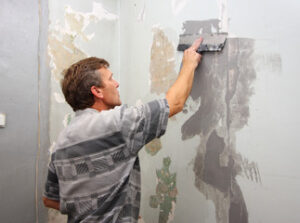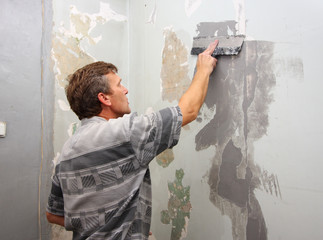Suppose your home has cracks in the stucco ceiling or walls, a leak in the basement, or crumbling stucco around windows. In that case, it is time to get professional advice and Stucco Repair Philadelphia.
 A full restoration should be done, including removing the old stucco, installing new building paper and metal lath, patching all areas of damage, and applying three coats of stucco repair mix.
A full restoration should be done, including removing the old stucco, installing new building paper and metal lath, patching all areas of damage, and applying three coats of stucco repair mix.
Stucco is tough and durable, but it can’t beat moisture. Moisture is stucco’s kryptonite, especially in climates that experience frequent freeze-thaw cycles or extreme snow and ice events. Water can absorbed by stucco and cause the surface to swell, then crack and separate from the structure behind it. This trapped moisture can eventually result in mold, mildew, and wood rot within the wall.
Often, these issues are caused by a simple repair job that wasn’t done correctly, or an older stucco system that is in need of complete remediation. This is a much more in-depth service than a simple patch, and can be more costly. However, continually postponing remediation will only increase the cost of repairs over time.
The first step in any stucco remediation project is a thorough inspection to determine if there are any underlying issues. Areas around windows are the most common areas for water intrusion, so this is usually where the inspection starts.
A good inspection should also include a moisture meter reading to see how much moisture is inside the walls. This involves inserting a small probe in the suspect area and measuring the amount of moisture present. This can be done by a professional or by the homeowner.
After the inspection, any leaking or damaged areas of the stucco can be repaired by covering them with a waterproofing membrane, then applying a new 1/4″ layer of stucco. This can be pre-mixed stucco that just needs to be troweled on, or a traditional stucco mix that is mixed in a wheelbarrow following the manufacturer’s instructions. A good stucco repair mix should be moist enough to hold a hose or brush, but not so wet that it will drip off the wall.
Once the new layer of stucco has been applied, it should be covered with a pigmented coating to match the color of the existing stucco and protect it from the elements. A sprayed-on acrylic elastomer works well for this, but mineral paints and lime washes are acceptable as well. The pigments used must be alkaline tolerant to avoid peeling.
Impacts
There are many environmental causes of stucco damage, but structural framing issues can also be a problem. If the sheathing and studs aren’t properly installed, they can rot and compromise the structure of your home. Stucco is a durable material, but rotting sheathing can cause walls to collapse and if left unchecked, it can spread to other parts of the house.
Stucco damage is easy to spot, especially if you keep an eye out for the key warning signs. These include cracking, chipping, staining and holes. Stucco that sounds hollow when tapped on is another sign that moisture has caused problems with the wall system.
While smaller cracks and surface stains can be patched, larger damage requires the expertise of a professional stucco repair contractor. Stucco repair involves removing the damaged portion of the wall and replastering it. This is a more in-depth process and requires specialized tools and techniques.
The first step is a complete inspection of the stucco wall system. This includes examining areas around windows and looking for evidence of water damage. If evidence of underlying issues is discovered, a remediation service may be needed.
This service includes a thorough inspection of the exterior of your home and the foundation to unearth any potential causes of structural damage. If the foundation is settling more than expected, a push or helical pier system can be used to support the home and bring it up to its practical maximum recovery. Once the foundation has been stabilized, the stucco can be repaired and a fresh coat of paint applied.
The main reason to have your stucco repaired as soon as possible is that it has a direct impact on the value of your home. Visible damage decreases your home’s value and makes it less attractive to buyers, which can be a deterrent to getting a good price when it comes time to sell. Moreover, a home that needs constant repair is stressful and can reduce the joy you take in your living space. Therefore, repairing your stucco before it becomes too serious is the best choice for you and your family.
Woodpeckers
Woodpeckers hammer away on stucco walls in search of a place to make a nest, mark territory and communicate. Their drumming creates a pleasing sound that proclaims the bird’s presence and attracts a mate. Woodpecker holes can be difficult to repair. In some cases, it may be best to replace the damaged area with a new wall. When that is not possible, you will need to protect the underlying metal lath support with an effective woodpecker deterrent. There are several different methods of protection, including motion-activated sprinklers, metallic covers and repellent paint.
During the breeding season, you should check for woodpecker damage at least once a day. It is important to note that woodpeckers don’t necessarily start at a hole and move from there, so an ongoing inspection will help you detect a problem early.
In addition to the usual monitoring, look for areas of water damage or mold. These are a sign that you should consider having your stucco repaired by an experienced contractor.
EIFS (Energy Insulation Finish System) and other types of wall cladding are very attractive to woodpeckers because they offer the kind of softer materials that would work for building nests. If you have this type of cladding on your building, regular inspections will help you spot a problem before it leads to costly damage and structural framing issues.
One popular method of preventing woodpecker holes is to use a product called Beakguard. This particular paint produces a taste and odor that the woodpeckers find repulsive. It is a highly effective method of woodpecker deterrence and should be your first line of defense in protecting your building from this nuisance bird. We once arrived to perform repairs on a condominium where many of the balconies had been decorated with fake owls in an attempt to scare off woodpeckers. Unfortunately, these simple visual deterrents don’t work as well as the more expensive and effective options such as Beakguard. A knowledgeable and experienced stucco repair company should know the best ways to protect your home or commercial building from this troublesome pest.
Settles
Stucco is a durable material, but the makeup of its composition can still leave it vulnerable to certain issues if not properly repaired and maintained. Stucco cracks are one example of this, and they can allow moisture to reach the wood framing of a house, potentially leading to rot or mold growth.
While many homeowners are able to handle minor cracks with caulking, the best way to address larger ones is to contact a stucco repair professional for help. These specialists will be able to assess the situation, determine the cause of the cracks, and recommend the best fix.
The most common reason for stucco cracks is foundation settlement. Often, these cracks appear around doors and windows or AC units, and they’re usually accompanied by other symptoms of foundation damage, including sticking doors or windows.
To fix these types of cracks, the first step is to remove any damaged pieces of stucco. This exposes the metal lath underneath, which should be inspected for signs of damage or rust. If necessary, the lath can be replaced with a new piece, securing it to the wood framing using roofing nails. Once the repair is complete, any moisture that may have gotten behind the stucco will now be unable to do so.
Another common cause of stucco cracks is the natural movement of a home’s foundation. This can create stress in the soil, causing it to expand and shrink. The constant movement can put strain on the foundation of a home, which in turn can lead to settling and cracking of the stucco and drywall of a building.
When this occurs, it’s important to take immediate action. A skilled stucco repair specialist can use cold chisels and hammers to widen the cracks to about 1/4-inch in width, then bevel the sides of the cracks into a V shape. Once the cracks are beveled, they can then be filled with an elastomeric caulking to accommodate for expansion and contraction that’s caused by temperature changes.
While the cost of stucco repair can sometimes be less expensive than the cost of remediation, it’s also a much more limited solution. Remediation requires stripping the exterior of a building down to the base layer in order to discover any internal sources of water damage, and then repairing those areas to prevent future problems.

